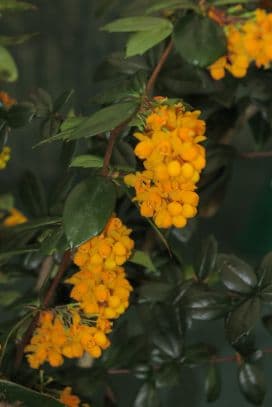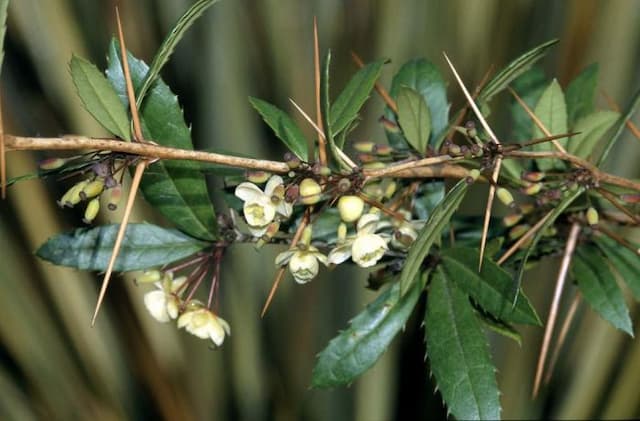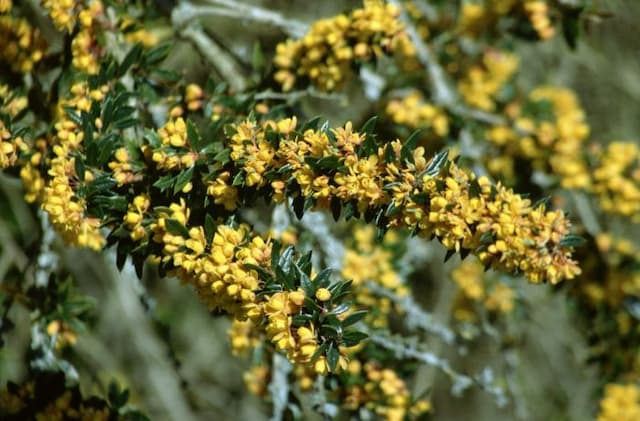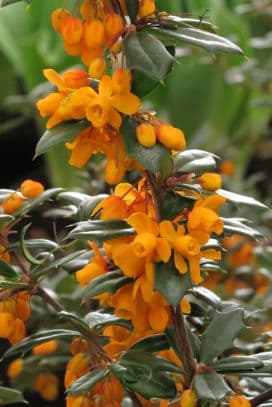Japanese Barberry Berberis thunbergii 'Diabolic'

ABOUT
Berberis thunbergii 'Diabolic', commonly known as Japanese barberry, is characterized by its distinctive foliage and thorny branches. The leaves are small and oval-shaped with a slight taper at the tip, boasting a rich, reddish-purple hue that adds striking color to the landscape throughout the growing season. As the seasons change, the leaves can transition to even deeper purples or sometimes fiery reds, particularly in the autumn. In spring, tiny yellow flowers dangle from the branches, contrasting beautifully with the dark foliage. These flowers may give way to small, bright red berries that persist into the winter and provide a food source for birds. The plant's branches are adorned with sharp thorns that make it an effective barrier or hedge. Its overall appearance is dense and bushy, presenting a lush texture in gardens due to its tightly packed foliage.
About this plant
 Names
NamesFamily
Berberidaceae.
Synonyms
Japanese Barberry, Thunberg's Barberry, Red Barberry.
Common names
Berberis thunbergii 'Diabolic'.
 Toxicity
ToxicityTo humans
The Japanese barberry is not generally considered highly toxic to humans, but it can cause mild problems if ingested. The berries, leaves, and roots could lead to digestive issues such as nausea, vomiting, or diarrhea if eaten in significant quantities. It is not commonly associated with severe poisoning or long-term health consequences for humans.
To pets
The Japanese barberry is similarly not highly toxic to pets. Ingestion of its parts, like in humans, can cause mild gastrointestinal upset such as vomiting or diarrhea in animals like dogs and cats. It is always best to prevent your pets from ingesting this plant, but it is not typically associated with severe or life-threatening toxicity.
 Characteristics
CharacteristicsLife cycle
Perennials
Foliage type
Deciduous
Color of leaves
Varies
Flower color
Yellow
Height
3-4 feet (0.9-1.2 meters)
Spread
4-6 feet (1.2-1.8 meters)
Plant type
Shrub
Hardiness zones
4-8
Native area
Japan
Benefits
 General Benefits
General Benefits- Aesthetic Appeal: Adds vibrant color to landscapes with its reddish-purple foliage and bright red berries.
- Seasonal Interest: Offers year-round interest with foliage color changes throughout the seasons and attractive berries in fall and winter.
- Drought Tolerance: Once established, it has good resistance to drought, reducing the need for frequent watering.
- Low Maintenance: Requires minimal care once established, making it suitable for low-maintenance gardens.
- Wildlife Attraction: Berries provide food for birds, while the dense foliage offers shelter and nesting sites.
- Soil Adaptability: Tolerates a range of soil types, from clay to loam, as long as the site is well-drained.
- Erosion Control: Its root system helps stabilize slopes and areas prone to erosion.
- Privacy Screen: Dense growth habit makes it effective as a natural privacy hedge or border plant.
- Pest Resistance: Generally resistant to many pests, reducing the need for chemical controls.
- Versatility in Landscaping: Suitable for use in formal hedges, borders, mass plantings, and as a specimen plant.
- Easy Propagation: Can be easily propagated from cuttings, allowing gardeners to expand their plantings.
- Climate Resilience: Capable of withstanding the temperature extremes in many climates without significant damage.
 Medical Properties
Medical PropertiesThis plant is not used for medical purposes.
 Air-purifying Qualities
Air-purifying QualitiesThis plant is not specifically known for air purifying qualities.
 Other Uses
Other Uses- Japanese barberry 'Diabolic' can be used to create natural barriers or hedges due to its thorny branches which deter animals and intruders.
- The vibrant foliage of the Japanese barberry 'Diabolic' is sometimes used for ornamental purposes in fall displays and floral arrangements.
- This plant's dense growing habit can provide erosion control on slopes or areas prone to soil degradation.
- The thorns of the Japanese barberry 'Diabolic' can be used as a natural deterrent for garden pests like rabbits and deer.
- Japnese barberry 'Diabolic', with its attractive berries, can serve to provide food for birds during the winter months.
- Japanese barberry 'Diabolic' can act as a windbreak in gardens or landscapes, especially in areas with harsh winds.
- The striking color contrast between the foliage and berries of Japanese barberry 'Diabolic' can be used to add visual interest to monochrome garden designs.
- Its hardy and resilient nature makes the Japanese barberry 'Diabolic' a candidate for reclaiming disturbed lands or industrial sites where other plants might fail to thrive.
- The plant's resistant qualities enable it to be considered for phytoremediation uses, helping to stabilize areas with mild contamination, though one should be cautious due to its invasive nature.
- By planting Japanese barberry 'Diabolic' alongside roads or walkways, its robust form can help to define spaces and create clear lines within the landscape design.
Interesting Facts
 Feng Shui
Feng ShuiThe Japanese Barberry is not used in Feng Shui practice.
 Zodiac Sign Compitability
Zodiac Sign CompitabilityThe Japanese Barberry is not used in astrology practice.
 Plant Symbolism
Plant Symbolism- Protection: Berberis thunbergii, commonly known as Japanese Barberry, often symbolizes protection due to its thorny nature, which can serve as a natural barrier against intruders.
- Resilience: The ability of Japanese Barberry to adapt to various soil types and environmental conditions denotes resilience and the ability to thrive despite challenges.
- Sharpness: The sharp thorns of the Japanese Barberry can symbolize a sharp wit or intellect, reminding one to stay mentally alert.
- Patience: As a plant that takes time to grow and requires patient care, it represents the virtue of patience.
- Bitterness: The genus name "Berberis" is associated with the word "barbarous," referring to the bitter taste of the fruits, symbolizing bitterness in life or experiences.
 Water
WaterFor the Japanese barberry 'Diabolic', consistent moisture is important, especially during the first growing season to establish a deep, extensive root system. Water the plant deeply at the root zone once a week, providing about 1 to 1.5 gallons of water each time for small shrubs, and 2 to 3 gallons for larger plants. During periods of drought or extreme heat, increase the watering frequency to twice a week. In cooler weather or with adequate rainfall, reduce watering as necessary to prevent waterlogging, which can cause root rot.
 Light
LightThe Japanese barberry 'Diabolic' thrives in full sun to partial shade. It prefers a spot that receives at least 4 to 6 hours of direct sunlight per day. Too much shade can result in a less dense habit and fewer flowers or fruits. The ideal location would allow for morning sun and some afternoon shade in hot climates to prevent leaf scorch.
 Temperature
TemperatureJapanese barberry 'Diabolic' is hardy and adapts well to a range of temperatures, flourishing in USDA zones 4 through 8. It can tolerate minimum temperatures down to -30°F and is comfortable in typical summer highs up to 90°F, though it is not averse to warmer temperatures. The ideal temperature range for optimal growth is between 60°F and 70°F.
 Pruning
PruningPruning Japanese barberry 'Diabolic' helps to maintain its attractive shape and size, and encourages fresh, vibrant growth. Prune in late winter or early spring before new growth starts by removing any dead or broken branches, and shaping the plant as desired. An annual pruning session is generally sufficient, though additional light trimming can be performed throughout the year to clean up the shape if necessary.
 Cleaning
CleaningAs needed
 Soil
SoilJapanese Barberry 'Diabolic' prefers well-draining soil with a mix of loam, peat, and sand. A soil pH between 6.0 and 7.5 is ideal for this shrub.
 Repotting
RepottingJapanese Barberry 'Diabolic' generally requires repotting every 2 to 3 years to refresh the soil and facilitate healthy growth.
 Humidity & Misting
Humidity & MistingJapanese Barberry 'Diabolic' tolerates a wide range of humidity levels and does not require specific humidity conditions.
 Suitable locations
Suitable locationsIndoor
Place in bright indirect light and well-draining soil for best results.
Outdoor
Plant in full sun to partial shade in well-draining soil.
Hardiness zone
4-8 USDA
 Life cycle
Life cycleJapanese barberry 'Diabolic' begins its life cycle as a seed, generally dispersed by birds that eat the plant's berries. Upon finding suitable soil, the seed germinates, typically in early spring, forming a seedling which then develops into a young plant. Over the next few years, the plant undergoes vegetative growth, forming a dense, thorny shrub with purple to deep red foliage. As it matures, usually within two to three years, it begins to flower in late spring, producing small, yellow flowers that are attractive to pollinators. Following pollination, these flowers develop into bright red berries by late summer to fall, which persist through the winter and are a key element of the plant's reproductive strategy. Japanese barberry 'Diabolic' can live for many years, continually growing and producing flowers and berries annually, with its lifespan largely determined by environmental conditions and care.
 Propogation
PropogationPropogation time
Early spring
The most popular method of propagating Berberis thunbergii 'Diabolic', commonly known as Japanese barberry, is through softwood cuttings. This technique is generally performed in late spring or early summer when new growth is still tender. Cuttings should be about 4 to 6 inches long, with a few leaves left at the top and the rest removed. The cut end can be dipped in rooting hormone to encourage root development. The cuttings are then placed in a well-draining potting mix and kept moist, with high humidity maintained by covering the pot with a plastic bag or placing it in a propagator. Rooting usually occurs within 4 to 8 weeks, after which the new plants can be gradually acclimatized to less humid conditions before being transplanted outdoors.







![Japanese barberry [Bonanza Gold]](/_next/image?url=https%3A%2F%2Fplants-admin.emdemapps.com%2Fimages%2Fplants%2F%2Fimages%2F604b5385e413f.png&w=640&q=75)

